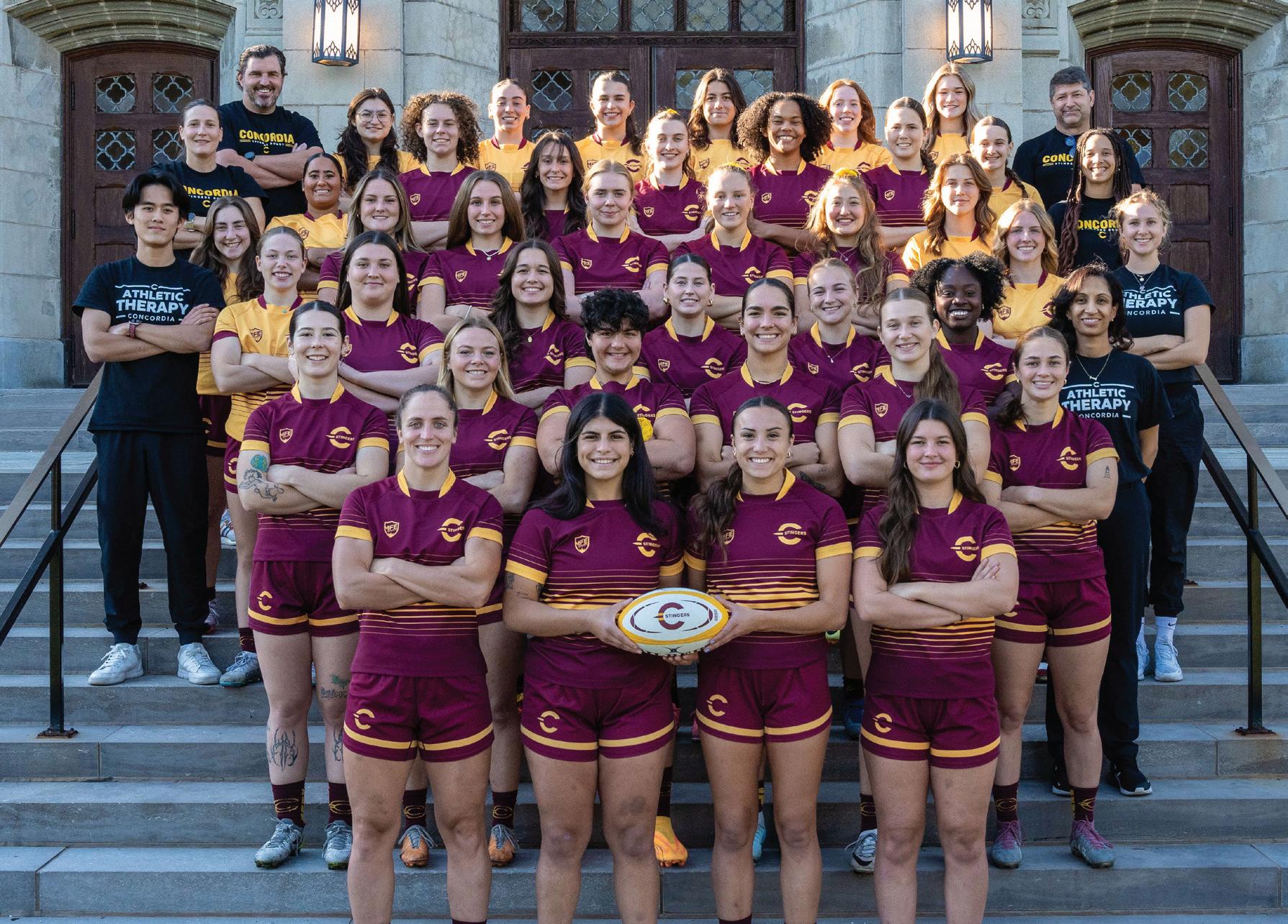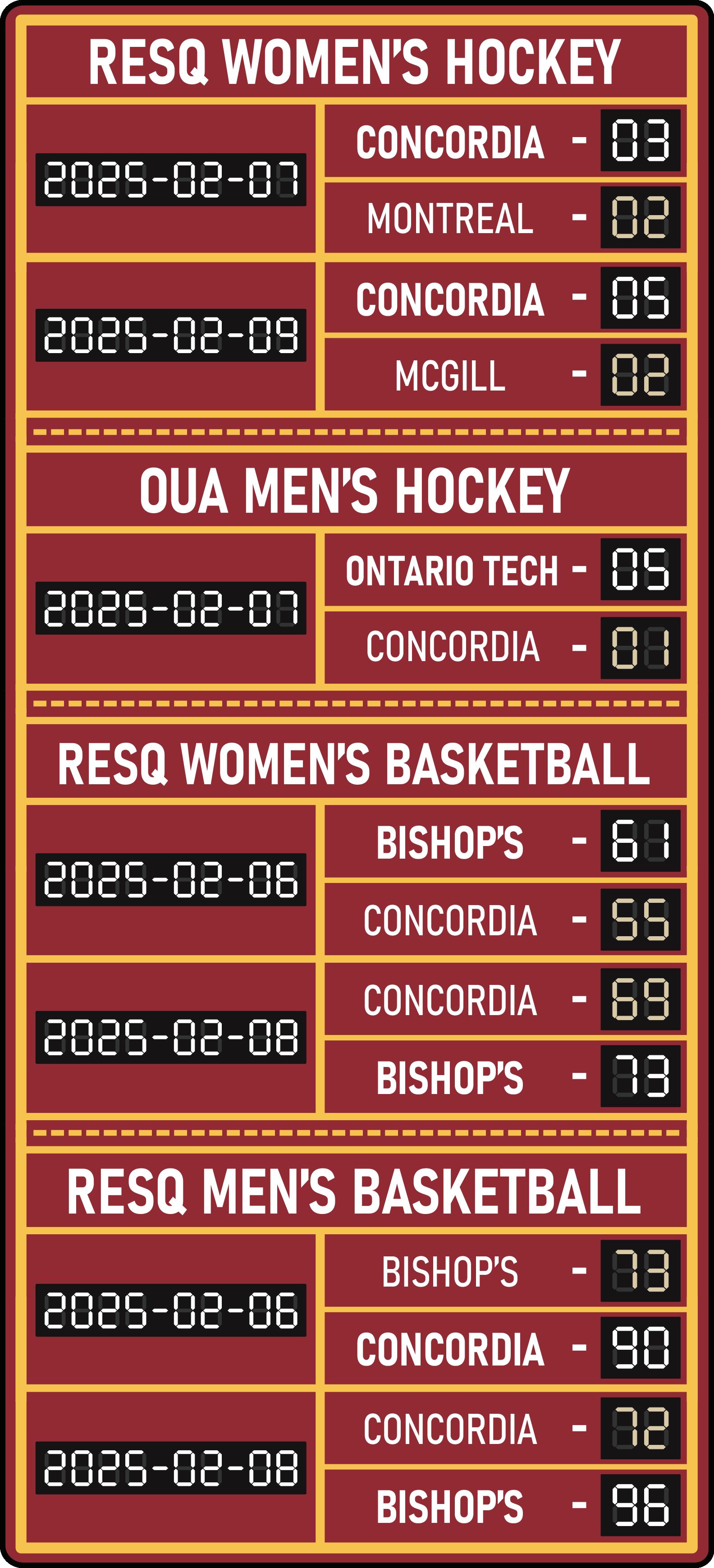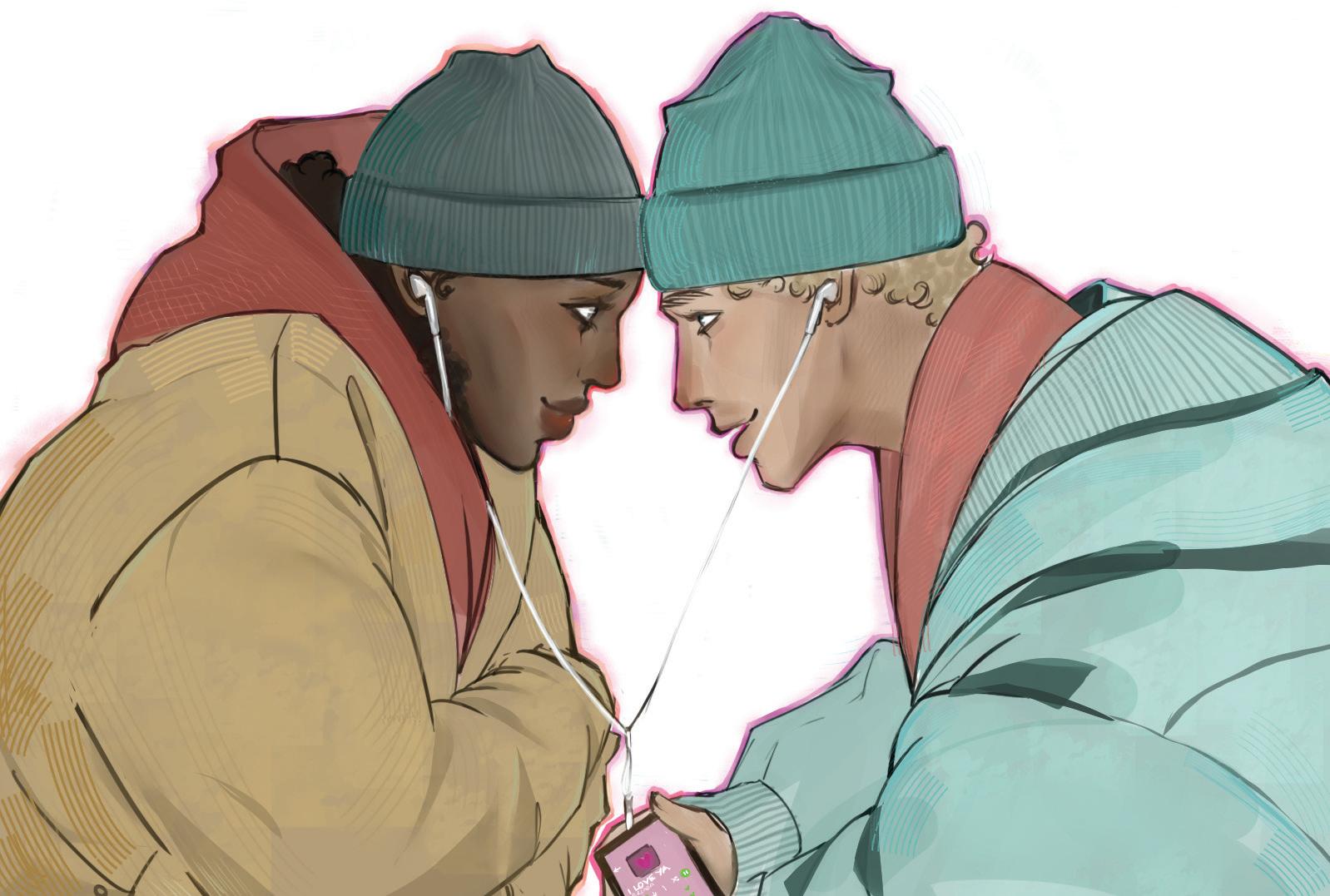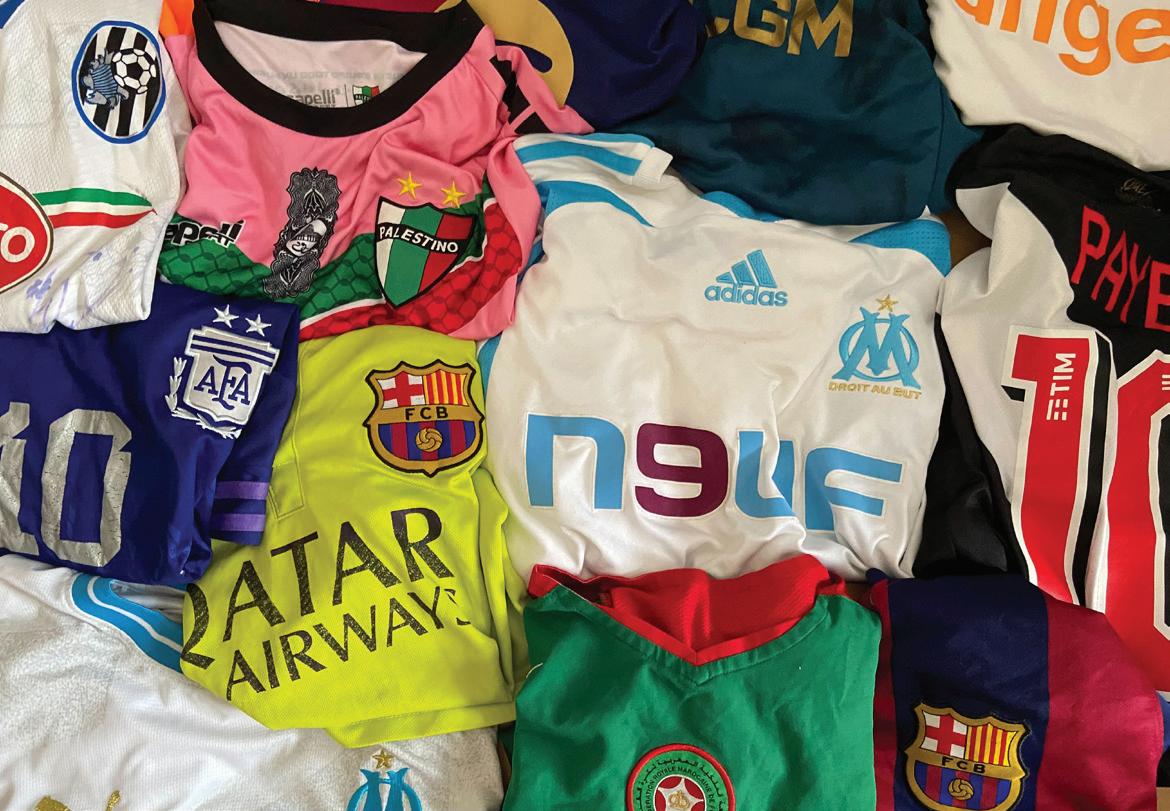




@theconcordianmtl
@theconcordian @theconcordian theconcordian.com







@theconcordianmtl
@theconcordian @theconcordian theconcordian.com

This new Concordian project brings
In October 2023, The Concordian’s News Editors received a cease-and-desist letter from Concordia University. The reason? The letter claimed that they had used the process of Access to Information “in bad faith” and as a “means of pressuring the University.” Through that experience and the ensuing mediation process, The Concordian has developed an interest in issues of transparency in Canadian universities. This led to an in-depth, award-nominated investigation
into the issue and to the creation of an investigative team. It has always been part of The Concordian’s mission to give students access to the inner workings of the university and to hold Concordia accountable for its actions. Now, we want to open the gates to this knowl edge and make it available to all Canadian students. Welcome to the Transparent University Project.
on pg.2
Concordia takes an important step regarding Black Studies pg. 4

Empowerment or Objectification?
Navigating the challenges faced by women rugby players pg. 6

Le Québec et l’intégration nationale, la réforme qui divise pg. 8


Resilience and community found through creative arts therapies at Concordia pg. 11
Staff Picks: Valentine’s Day pg. 13


Valentine’s Day outside of cisheteronormativity


Access to Information (ATI) requests are made possible through access to information legislation across provinces, which gives Canadians the right to access information held by public institutions, including information like safety reports, harassment complaints, or internal memos.
These laws date back to the 1980s and were implemented to give Canadians the tools to hold institutions accountable for the way they are run. While they are often used by journalists, anyone can file ATI requests to public institutions.
As explained by Dean Beeby, freelance investigative journalist, freedom-of-information specialist, and transparency advocate, “The genius of the Access to Information Act and all of these freedom of information legislations was it empowered ordinary people, citizens, to command information.”
Projects like The Globe and Mail’s Secret Canada or the Investigative Journalism Foundation work to give Canadians access to information about the country’s biggest and most opaque institutions.
However, universities are underrepresented in many of these databases.
Universities are governed by provincial access to information legislation, meaning the process of filing an ATI request varies from province to province.
In Quebec, ATI requests are free, although some fees relating to the preparation of the documents may be requested. Once you submit a request, either verbally or in writing, the institution has 20 days to deliver the documents. It can extend that deadline by 10 days from the get-go and can request additional extensions if the request involves third-party information.
Some information, including personal information, is exempt from ATI laws. For more information, visit
the Commission d’accès à l’information website.
In 2024, The Concordian investigated Concordia’s Access to Information track record. We wanted concrete data on whether the university was fulfilling its legal obligations.
We found that, between January 2021 and May 2023, ATI files at Concordia were open for an average of 52.4 days, the highest of any university in Montreal.
However, the scope of our investigation was wider than Concordia, and the picture in the rest of Canada also raised concerns. At the University of British Columbia, ATI files were open for an average of 176 days.
The Transparent University Project is both a database and a tool to help you file further ATI requests.
On this new section of our website, you’ll find a list of ATI requests filed by The Concordian and the documents we obtained from them.
Many of these requests relate to previous ATI requests filed to dozens of universities in Canada. To access the files released following those requests, you can file a piggyback, meaning requesting the same information from that public institution. This is the easiest way to retrieve information from an institution, as the information has already been published.
You can use our database and ask for the documents from a specific request. This will save you time and money from requesting the information from scratch.
On the Transparent University page, you’ll also find an ATI generator.

This tool is meant to help you draft up your own request to public institutions in Canada. Information requests can be very difficult to word effectively — often, they require knowledge of the document before you request it to narrow in the scope.
This generator is modelled off of our newsroom’s request style. Input the information you are looking for and the dates, and it will draft a copyable request with information on how to file it to your university, wherever it is in Canada.
There might be some hiccups with contact info — if so, let us know, and we will update it. However, the generator already has the language, provincial information act, and institutional legal name preloaded. With this being such a new tool, we would love to hear suggestions on ways to improve it. And if you can’t find your publicly funded institution, let us know.
The Transparent University Project will keep growing as we continue to file ATI requests in the coming months and years. Keep an eye out for future updates!
To access The Transparent University Project, scan the QR code:
The deadline to avoid fees for services offered by the CSU is approaching.
BY JEREMY COX NEWS EDITOR
The Concordia Student Union (CSU) added various student services to undergraduate student’s winter semester fees. Here’s what you should know about them.
Last summer, CSU executives signed a partnership with health plan provider Studentcare. This automatically provided legal care services for the undergraduate student body, called the Legal Essentials Service. Students voted to keep the plan with 58.2 per cent approval during the union’s by-elections in November.
The service provides legal consultation and possible legal representation in “eligible areas of law” through a partner firm. Requests for legal representation can be turned down if they have no legal basis, a low probability of being granted by a court, and if the request is disproportionate to the magnitude of the problem.
Students now owe a yearly fee of $30 for this service. On Jan. 22, CSU members received an email explaining that a fee of $20 had been added to their student accounts. Students have until Feb. 20 to opt out of the program and payment. To opt out, students must access the Studentcare portal.
one visit. Service fees total $10.95 per year, with a $7.30 bill in the wintertime. The opt-out deadline is also on Feb. 20.
To opt out of Maple, students must access the Maple website and fill out the opt-out form. It may take up to a month for a credit to appear on student accounts. Students have the option to select annual or permanent opt-outs, with the former re-enrolling the student the following p olicy year.
The service is billed separately from the Studentcare Health and Dental Plans, which automatically provides services to Quebec and Canadian students. International students, who are not automatically covered, must have a provincial health care card to access this coverage. These students must either wait until the following Fall or Winter semester to complete the enrolment process or contact Studentcare within two weeks of receiving the health care card and unenroll in the Concordia Health Insurance Plan for International Students.
Project leads: Aidan Raynor and Marieke GlorieuxStryckman.
The CSU charges a fee for its Telemedicine service provided by Maple, a mobile web app that puts students in contact with general practitioners. According to Maple’s website, 91 per cent of medical issues are resolved in only
Studentcare includes different 2SLGBTQIA+ support plans such as gender-affirming care, mental health and wellness and health coverage. Students have access to the plans, and their dependents have access to Mental Health and Wellness and 2SLGBTQIA+ support plans, provided they are covered by the Studentcare Dental Plan.
The HOJO launches clinics to educate students about rental increases.
MEGAN MILLS DEVOE NEWS EDITOR
The Concordia Student Union (CSU) off-campus Housing & Job Resource Centre (HOJO) hosted their first rental increase clinic of the year on Feb. 5. These clinics seek to educate students about their rights as tenants and provide information about how to proceed after receiving a proposed rent increase from their landlord.
According to lead HOJO assistant Olivia Mallette, the number of students seeking HOJO’s services to contest rental increases is “huge.”
“I’ve been working here for three years now, and I do think that every single year, more and more people come in to learn how to refuse their rent increases,” said Mallette.
Mallette said that this year in particular, she is anticipating a significant increase in the number of students seeking help.
In January, the Tribunal administratif du logement (TAL) announced a 5.9 per cent average recommended rent increase for units that do not include heat in the cost of rent. According to CBC, this represents the highest average increase in the last 30 years.
Mallette said that many students are unaware of their options following a notice of rent increase.
“They think that they can’t
refuse their rent increase,” said Mallette. “They think that if they refuse it, it means that they have to leave.”
This is not the case.
After receiving a notice of rent increase, tenants have three options: accept the increase and renew their lease, reject the increase and end their lease, or reject the increase and renew their lease.
Maria Oliveira, the HOJO assistant who led the clinic, emphasized that the TAL average is only a guide and will not apply to all tenants. She said it is often in the best interest of the tenants to try to negotiate with their landlord before accepting an increase to their rent.
Quebec has no official limits on how much landlords can or should increase rents, but tenants have the right to contest proposed increases that they feel are arbitrary or unreasonable. Although there is a recommended average, tenants have the right to have their rent calculated by the TAL so that it matches the actual cost of upkeep to their building and unit.
In most cases, tenants have the right to refuse an increase while renewing their lease. Exceptions include tenants who live in housing co-ops, tenants who live in buildings under five years old, and tenants who live in buildings that have been re-zoned within the last five years.
Once a tenant refuses a rent increase, it is up to their landlord to organize
a hearing with the TAL. These hearings involve a thorough review of a landlord’s yearly expenses to determine the validity of the proposed increase.
Mallette acknowledged that the prospect of attending a hearing may be intimidating to some students.
“A lot of students are afraid to assert their rights to refuse
their rent increase because they’re afraid it’s going to give them a name at the TAL,” said Mallette. “They’re afraid that it’s going to affect their ability to rent.”
According to Mallette and Oliveira, it is highly unlikely that this type of hearing will impact your ability to rent in the future. Oliveira also advised


students to block out several hours if they need to attend their hearings, which can be quite lengthy.
The clinic on Feb. 5 was the first of nine confirmed HOJO workshops. Clinics will continue to be held in-person and online until mid-April. Specific dates and times can be found on the HOJO website.


BOG members claimed they are investigating the Concordia Student Union for various occurrences at the Jan. 29 SGM.
BY JEREMY COX AND CHANTAL BELLEFEUILLE NEWS EDITOR AND COPY EDITOR
On Feb. 6, Concordia University launched an investigation into the Concordia Student Union’s (CSU) Jan. 29 special general meeting (SGM), as stated in the letter addressed to the CSU from Provost and Vice-President Anne Whitelaw and Vice-President, Services and Sustainability of Concordia University Michael Di Grappa. Concordia is investigating the alleged issues caused un-
der the CSU’s supervision, such as hosting more people in the H-110 auditorium than legally permitted, allowing the People’s Potato to serve food in the auditorium without authorization and blocking fire exits, and permitting conduct that they claim created a hostile climate for members of the Concordia community.
At 4 p.m. on Feb. 6, the CSU presented the SGM’s first motion to the Concordia University Board of Governors (BOG), as outlined in the second motion. Outside, a protest was simultaneously held promoting the Boycott, Divestment, Sanctions (BDS) movement, where people denounced Concordia’s investments in companies connected to the Israel-Palestine conflict.
Although the BOG meeting was labelled an open session, only those who were invited were allowed to attend. As of
Feb. 10, Concordia has not provided any statement about the decisions made during the meeting.
Concordia president Graham Carr published a letter on Jan. 30 opposing the BDS movement. According to Carr, the SGM included discriminatory behaviour and the use of intim idation tactics. Both the Jan. 30 and Feb. 6 letters mentioned that “heavily masked indi viduals” were correlated with the intimidating climate.
“Such campaigns are contrary to the value of academic freedom upon which all universities are founded,” Carr stated.
The CSU will be barred from booking spaces at Con cordia until the investigation concludes.
The CSU stated in a respond ing letter that the university
has given more consideration to vandalism than the physical harm of Palestinian students, referring to the assault that occurred on Dec. 17 in the Hall building. According to the letter, Concordia’s characterization of the student-led aca-
“We cannot have academic freedom without the freedom to acknowledge the active genocide against the Palestinian people,” the statement concluded.


After a wait of over 50 years, Concordia launches its Black and African Diaspora minor.
BY ASHLEY GAUTHIER CONTRIBUTOR
This coming fall, the new minor in Black and African Diaspora Studies in the Canadian Context will launch at Concordia University.
“We’re the first in Quebec with this program, so we’re very happy and very excited,” said Christiana Abraham, se nior lecturer in communication studies and the program’s inau gural director.
While the program has been officially in the works for the last two years, the demand for Black studies at the university dates back over five decades. The discrimination and racism faced by Black and Caribbean students at the time led to the 1969 Sir George Williams Uni versity protest. Demands for resources, better represen tation, and more inclusive programs grew bigger.
In a preliminary re port shared in 2021, the Anti-Black Racism Task Force recom mended the inclu sion of such a field of study. This rec ommendation was made for various reasons, including in reaction to George Floyd’s death in 2020.
The minor will focus on hip-hop and African popular cultures, as well as African diasporas and histories from the Canadian perspective. Courses will include Black Studies, Black Montreal and Race and Ethnic Relations.
Students are already voicing their interest in the program.
“It’s very amazing to see it finally come to pass because it’s a very good first step in the right direction when it comes to the representation of the Black community from an educa -
Joyner reported being lucky to have an agreeable experience at Concordia, both as an undergraduate and graduate student. Although, he recognized that not everyone had the same experience.
“I want to ensure that everybody has the type of experience that I have but is also able to go and understand their community the way that I’ve grown to understand our Black community,” he added. “To make sure that we have the support
systems that I could have benefited from.”
For Abraham, the curriculum has a deep sentimental value. As program director, she said she based the minor on subjects she would have liked to learn about when she was a student at Concordia.
“My interests revolve around interrogating Blackness, interrogating marginality, interrogating ideas and lived experiences of people of the African diaspora,” she said.
According to Abraham,
of the president’s Task Force on Anti-Black Racism and advisor to the provost on Black integration and knowledge, Concordia was asked several times to include more Black professors and faculty members as well as Black studies courses.
“What we have here is a group of very important Black scholars who are emerging from Canada and doing some incredible work around the Black condition in Canada, the Black experience in Canada and what it is like to be Black in Canada,” said Abraham.

Looking at the future, Willkie has several plans.
“My personal priority would be to go from the minor to an undergraduate certificate to a graduate certificate and perhaps create a possibility for there to be courses at the PhD level,” she said.
Joyner had a similar vision regarding the expansion of the program.
“If I had it my way, I would see it become a major, be institutionalized, and just kind of grow bigger and bigger and more efficient every year to be kind of one of the staples of Concordia,” he said.
Preparations for a launch event set to take place in the fall have begun. This occasion will honour the Black presence at Concordia and recognize the efforts made by students, faculty and staff.
“We need to celebrate; it’s been over 50 years,” Willkie said.


Community members gathered to learn about the challenges that temporary immigrants face in the province.
BY MEGHRI GHAZARIAN CONTRIBUTOR
Students from Concordia’s School of Community and Public Affairs (SCPA) gathered community members at the Maison du développement durable on Feb. 5 to delve into the issues surrounding temporary immigration in Quebec.
The panel, Breaking the Paradox of Temporary Immigration in Quebec, focused on the limited acceptance rate of migrants coming to Que-
bec despite their contribution to prosperity and growth in the province.
The guest panelists were Cristina Rogov, an immigration lawyer of Exeo Attorneys, Henriette Mvondo, the founder of Bienvenue à l’Immigrant, and Yasmine Yahiaoui, a SCPA alumni with a minor in immigration and currently a legal assistant.
“Temporary foreign workers

directly contribute to the Canadian economy by providing their expertise,” said Rogov.
However, she said she has noticed a notable decrease in the number of people applying to move here for work or education.
According to her, many of these individuals are being denied entry to Quebec. She said the provincial government is questioning whether or not they are contributing and integrating themselves into the community.
Policies such as Bill 74, which restricts the number of international students who are able to enroll in higher education institutions, are being implemented to freeze the number of international students coming in.
SCPA student and event organizer Sophie Boulos indicated that it can be very daunting for those who wish to live here.
“I hope that they can take away that they also have some power and there are resources available should they ever encounter immigration challenges,” Boulos said.
Throughout the evening, some student attendees raised their concerns about their positions, originating from out of province.
Samuel Gold, an out-of-province student studying at the SCPA, believes that the topic of immigration is very relevant, especially for students.
“In Quebec, people seem to have really polarized opinions on immigration,” said Gold.
“It’s starting to become clear to me that students are treated more like an economic commodity more than anything else.”
According to Yahiaoui, a lot of stereotypes are created around the idea that temporary immigrants come to Quebec and do not devote any of their time to integrating themselves into their communities.
“A lot of students come here because they want to stay here,” said Yahiaoui.
Organizations such as Bienvenue à l’Immigrant help guide immigrants in their new lives and connect them with community leaders.
CREW will start discussing a strike mandate as early as Feb. 17.
MEGAN MILLS DEVOE
NEWS EDITOR
Concordia Research and Education Workers Union (CREW) has started demonstrating lead-
ing up to their upcoming special general assemblies. These general assemblies will focus on discussions of future pressure tactics as well as voting on whether or not to strike.
On Feb. 5, CREW organized their first demonstration in the Hall mezzanine, which brought together around 150 participants. This was followed by a second demonstration in the
SP building the following day.
CREW External Affairs Officer Lauren Laframboise said that these events align with the “pressure tactics mandate” adopted by the union on Jan. 30.
“We think that [pressure tactics are] what we need in order for Concordia to give us an offer at all, let alone a realistic offer that we’d be happy with,” she said.

CREW has been in negotiations with Concordia for several months regarding the state of their collective agreement. These negotiations centre around improvements to working conditions and increased pay.
According to Laframboise, many teaching assistants (TAs) currently have contracts that do not reflect the number of students they are expected to support.
“We really feel that our working conditions are stu-
dents’ learning conditions. We want to be able to do a good job, and we need enough hours to do that,” said Laframboise. Many of the TAs who spoke at the event also expressed that they needed to work several contracts at a time in order to support themselves financially.
“I worked three contracts as a fulltime student last year; I wouldn’t wish that on my worst enemy,” said Stephen Friedrich, a CREW member and former bargaining committee member. “I am not unusual; I am typical.”
Concordia’s TAs are currently being paid $29 per hour and are
fighting for an increase to $45 per hour.
“We are vastly underpaid compared to other workers at other universities,” said Laframboise. “We find it unacceptable that we haven’t received a counteroffer from Concordia yet.”
Laframboise said that CREW has received overwhelming support from both the CSN and non-CSN-affiliated Concordia unions.
“Many [members of other Concordia unions] were in attendance at both [demonstrations],” said Laframboise.
Association of Graduate Students Employed at McGill (AGSEM) Office Assistant Kiersten Beszterda van Vliet was one of many external supporters who spoke at the Hall building demonstration.
“On the first day of our strike, CREW showed up in huge numbers … Every day of your strike, every day of your struggle, AGSEM will be there with you,” said van Vilet in a speech addressing CREW.
CREW will hold special general assemblies for strike votes on Feb. 17, Feb. 19, and Feb. 22.
The #BeStrong BeBeautiful campaign, featuring Team Great Britain rugby players, sparks a debate over the balance between empowerment and objectification.
BY ISABELLA BELAFI CONTRIBUTOR
When Great Britain rugby players Jasmine Joyce, Celia Quansah, and Ellie Boatman posed in lingerie for Bluebella’s #BeStrongBeBeautiful campaign, they wanted to show that strength and femininity can coexist.
The campaign sparked mixed reviews, with some praising the empowering message and others criticizing it for reinforcing gender stereotypes. A headline on a British website stated: “Former Olympians Slam ‘Shameful and Regressive’ Lingerie Campaign Featuring Team GB Rugby Players.” Another from The Brisbane Times read: “Sorry, but rugby players
posing in lingerie in 2024 is not ‘regressive.’”
The success of female athletes throughout the 2024 Paris Summer Olympics has caused women to dominate the headlines. However, as media representation grows, so does the complexity of the ways female players are portrayed. The campaign reaction reignited an important debate: can there be a balance between empowerment and objectification?
On the one hand, some argue that female athletes displaying their femininity help break gender stereotypes, while on the other, some say it reinforces those stereotypes, shifting focus away from their athletic talent.
These struggles are all too real for the Concordia Stingers women’s rugby team.
This season, the Stingers women’s rugby team secured third place in the Réseau du sport étudiant du Québec (RSEQ), missing by one position to go to nationals. Despite their strong performance, players report feeling undermined as female athletes.
“When the team was selling tickets to our game, a guy from the Concordia football team approached us,” said

McTavish. “He said, ‘What do you guys need money for? It’s not like you’re actually going anywhere.’”
A 2014 study by Canadian researcher Elizabeth Hardy in 2014 highlights these struggles. Hardy discusses the social construct called the “female apologetic behaviour.” This shapes how women are expected to look and act, reinforcing gender hierarchies.
According to the study, female apologetic behaviour is when female athletes feel the need to conform to traditional femininity to remain socially accepted. This is done by presenting themselves more femininely through sexier clothing, avoiding muscle growth, and wearing makeup, among other traits.
Hardy’s study of nine Canadian female rugby players also highlights how societal expectations of femininity influence behaviour. The athletes felt pressured to counteract rugby’s stereotypical images by appearing more traditionally feminine, avoiding behaviours seen as “masculine” or “lesbian.” They also said that media coverage prioritizes their appearance over their athletic achievements, emphasizing traditional feminine roles.

Madeleine McTavish, 22, a Stingers rugby player, expressed similar sentiments about societal pressures.
“I’ve felt the need to present myself more femininely because so many aspects of who I am — playing rugby and being a bisexual woman — align with these stereotypes,” she said.
McTavish’s rugby
journey began during high school when her chemistry teacher decided to start a girl’s team. Having played soccer previously, she was looking forward to trying a new sport.
This year marks her fourth season with the Concordia Stingers.
“I’m my own worst critic, but I’ve rationalized that if I didn’t have a strong body, I wouldn’t be able to succeed,” said McTavish. “But that insecurity never completely goes away.”
Hannah Booler, 22, who also plays on the Stingers rugby team, shared her struggles with feeling feminine.
“I don’t often wear dresses or high heels because I don’t feel completely comfortable,” Booler said.
Booler has been an athlete most of her life, playing sports like swimming and soccer. She has played rugby for nine years and has dedicated the last four years solely to the sport.
“What we see in the media is what we aspire to be,” Booler said. “When I was younger, I would watch the Victoria’s Secret show and watch these models with hourglass figures and tiny waists. It created these standards of what body goals are. Meanwhile, I also wanted to be an athlete.”
Female apologetic behaviour can blur the line between celebrating femininity and succumbing to objectification. Hardy’s study emphasizes the contradiction athletes feel between empowerment and the need to conform to feminine ideals to gain acceptance of media attention.
Embracing femininity can be empowering, challenging the stereotype that athleticism is inherently “masculine” and proving that women can excel while expressing their individuality. However, there’s a risk of objectification, reducing female athletes to their appearance instead of their skills.
“Athletic bodies may not be the conventional beauty standard for models,” Booler said. “But the coverage from the Paris games showed Olympic body types, how powerful women could be, no matter their stature.”
McTavish also addressed the stereotypes the team has encountered.
“A common one is that all female rugby players are gay, which is obviously not true,” she said. “One time, we were out at a bar, and when people found out we were a rugby team, their first reaction was, ‘Oh, so are you all dating each other?’”
The team often uses humour to address these assumptions, even playfully checking the statistics each year to see how many players identify as straight and how many don’t.
“This season, it was an even 50:50 split,” McTavish shared.
At the 2024 Olympics, female athletes won 17 of Canada’s 27 medals, making up the majority of the medals. This has led to more media coverage and a growing appreciation for women’s contributions to sports.
Headlines like “Paris Potential: Women’s Olympic Successes Suggest a New Athletics Era” from The Grand Valley Lanthorn and “Women’s Sports Are Having a Moment. The Olympics Are Showing Why” from the Christian Science Monitor highlight this shift.
While these headlines reflect progress, they also reveal a bigger issue: women’s achievements are still framed as “groundbreaking,” implying that recognition is long overdue.
“I love the positive attention women’s sports are getting,” McTavish said. “But it feels like all the women who paved the way missed out on this recognition. We’ve been having this moment, people are just realizing it now?”

A challenging week saw both Stingers basketball teams fall to Bishop’s, while men’s hockey suffered a tough loss.
BY GASPARD BEAUDOIN CONTRIBUTOR
The Concordia Stingers faced a tough week, with both basketball teams falling to Bishop’s despite standout individual performances. The men’s team saw its 10-game win streak come to an end, while the women’s team fell just short in two hard-fought battles.
Meanwhile, the men’s hockey team suffered a disappointing loss to Ontario Tech, leaving the women’s hockey win as one of the rare bright spots of the week.
Here’s a closer look at the games:
BASKETBALL
The men’s basketball team delivered an impressive performance on Feb. 6, securing a 90–73 victory over the top-seeded Bishop’s University Gaiters. Stingers guard Ju-
nior Mercy showcased a stellar performance, scoring a season-high 37 points, the most in a single game this season so far.
Two days later, they faced the Gaiters once again, this time on the road. Unfortunately for the Stingers, they couldn’t manage to challenge the firstranked team and ended up losing 96–72. Mercy once again was in good form as he managed to rack up 23 points, even though it wasn’t enough to lead his team to victory. This game marked the end of the Stingers’ winning streak of 10 matches.
They will look to get back on track in their next game against the Rouge et Or of Université Laval on Feb. 13.
The women’s basketball team faced a tough challenge against Bishop’s University in their matchup on Feb. 6. Despite a strong defensive effort as underdogs, the Stingers fell short in a 61–55 loss. Shooting guard Victoria Lawrence, who has been a standout player all season, led the defensive effort with seven steals.
On Feb. 8, the women Stingers faced the Gaiters once again, this time losing by an even closer margin, 73–69. Centre Serena Tchida’s efforts will be noted as she scored a whopping 30 points, the most
a single player achieved in any match this season.
The Stingers will now shift their focus to their next matchup against the league leaders, the Rouge et Or, on Feb. 13.
The men’s hockey team endured a tough outing on Feb. 7. The team suffered a blowout 5–1 loss against the Ontario Tech Ridgebacks at Ed Meagher Arena. Despite the defeat, the Stingers dominated in shots, outshooting their opponents 37 to 15. Goaltender Jordan Naylor had a night to forget, managing only five saves on 15 shots, with a save percentage of 66 per cent.
The Stingers will now look to bounce back in their next fixture against the York University Lions.
The women’s hockey team faced McGill’s Martlets on Feb. 9. Despite a quiet first period, the Stingers ended up winning 5-2 with a brace from forward Megan Bureau-Gagnon, who was named star of the match.
They will now look forward to their game against Bishop’s University Gaiters to continue their dominating season.
The Stingers outshot their opponent 37–15 only to suffer their third home loss of the regular season.
BY ANTHONY MURUCA CONTRIBUTOR
Concordia was given a taste of their own medicine against the Ontario Tech Ridgebacks on Feb. 7. Six days after the Stingers beat Ontario Tech by a score of 5–1, the Ridgebacks
avenged their loss by winning 5–1 themselves.
Prior to the game, Stingers defender Simon Lavigne and forward Mathieu Bizier were honoured for their efforts in winning gold at the International University Sports Federation (FISU) Winter World University Games this past month in Italy.
As the puck dropped, the opposing Ridgebacks got an early jump on the Stingers. Ontario Tech capitalized on an oddman rush to give themselves a 1–0 lead three minutes into the frame. Ontario Tech started

the game with a tenacious forecheck and made an emphasis on finishing their checks on both ends of the ice.
The Stingers appeared to have gotten the equalizer at 14:01, but the goal was waved off by the official as it was ruled that an illegal kicking motion was used to score.
Shortly after, several players on each team were involved in a scuffle after Ridgebacks’ Braiden Koran delivered an illegal behind-the-back hit on Stingers defender Christopher Inniss. Inniss was shaken up but was able to return not long after being evaluated by team doctors.
The physical nature of the game stayed strong into the second period as both teams exchanged hard checks along the boards. Officiating was strict but consistent throughout the game, as both teams were assessed a total of 38 penalty minutes. For reference, only 14 total minutes were given to both teams combined in their previous matchup on Feb. 1.
Ontario Tech took advantage of a Stingers turnover that led to a breakaway goal, making the score 2–0 with six minutes remaining in the second period.

Shortly after, the Ridgebacks scored their first power-play goal of the game to make the score 3–0 with 4:22 remaining.
The three-goal deficit did not discourage the Stingers as they kept testing the Ridgebacks’ netminder. Unfortunately for them, they were unable to convert on any of their high-danger scoring chances, despite leading in shots on net 29–9 at the end of the second frame.
The third period was more of the same from the Stingers, who were constantly frustrated by a lack of opportunity on offence and unnecessary penalties. Ontario Tech sealed the game by scoring twice in frame, opening up a 5-0 lead.
The Stingers spoiled the opposing netminder’s potential shutout performance, as defender Kyle Havlena buried a one-timer with six seconds remaining in the game. The power-play goal was the first tally on eight opportunities in the entire game.
“All teams [in this division] could beat anybody on any given night; you could run into
a hot goalie and not be able to score, and that’s what happened tonight,” said Stingers head coach Marc-André Elément post-game. “We didn’t give up a lot of shots, but they capitalized on their chances, so they deserve the credit.”
Stingers defender Lavigne was tasked with playing lots of difficult minutes against Ontario Tech’s physicality, but he wasn’t phased by the Ridgebacks’ game plan.
“A good hit on the shoulder is just as painful as an illegal hit,” said Lavigne post-game. “You just have to answer the bell and do it legally.”
Lavigne and the Stingers hope to rally and finish the season strong as they head into their final two matchups of the regular season on the road.
“We have stuff to work on, but we’ll build on the positive and learn from the negative in that game,” said Lavigne.
The Stingers have a week off before visiting the York University Lions on Feb. 14. Puck drop is set for 7:15 p.m.
En partenariat avec et financé par l’Organe.
Le gouvernement
Legault souhaite redéfinir
l’intégration des immigrants avec la loi 84, une réforme qui suscite autant d’adhésion que d’inquiétudes.
BY LISON FAURE
COLLABORATRICE
Le gouvernement Legault a déposé le projet de loi 84, une mesure législative visant à réaffirmer l’approche du Québec en matière de politiques d’intégration et d’immigration, le 30 janvier dernier.
Présenté par Jean-François Roberge, ministre de l’Immigration, de la Francisation et de l’Intégration, comme nécessaire à la préservation de l’identité québécoise et de la cohésion sociale, il est dénoncé par d’autres qui pointent du doigt un renforcement des barrières culturelles et linguistiques pour les nouveaux arrivants.
Alors que les débats s’intensifient, retour sur les enjeux et les implications de cette réforme.
LE STATUT PARTICULIER DU QUÉBEC
Cette loi-cadre, qualifiée de contrat social par le ministre, cherche à réaffirmer ce qu’il considère être les valeurs fon damentales du Québec. Parmi celles-ci, on compte notam ment la valorisation de la langue française comme langue officielle et
d’intégration, l’égalité homme-femme, ou encore la laïcité de l’État.
Cela s’inscrit dans une longue lignée de démarches similaires cherchant à affirmer le statut unique de la province au Canada et ciblant le modèle du multiculturalisme établi en 1971 à l’échelle fédérale. Ce modèle n’a jamais été accepté par le Québec. « [Le multiculturalisme] ne priorisera probablement pas les sortes de protection dont le Québec a besoin, du point de vue linguistique et culturel, dans un océan de culture anglophone dans le reste du Canada et de l’Amérique », explique Dónal Gill, professeur adjoint de politique canadienne à Concordia.
Jean-François Roberge dit souhaiter promouvoir l’interculturalisme, un modèle qui ajoute la notion de culture commune, là où le multiculturalisme se contente d’un assemblage de cultures diverses. Le ministre désire ainsi éviter un repli sur soi-même et une soi-disant « ghettoïsation » de la société. Selon lui, « le Québec est plus que l’addition de plein de personnes », ce qu’il a affirmé lors d’un point de presse à l’Assemblée nationale le 28
ité d’une stigmatisation accrue des immigrants et des minorités ethnoculturelles, érigeant des barrières supplémentaires à l’intégration.
« La formulation de cette loi présuppose qu’il existe un problème de manquement délibéré à l’intégration de la part de minorités, qui seraient activement hostiles aux valeurs québécoises », affirme le Dr. Gill.
Bien que le discours de JeanFrançois Roberge s’en éloigne maintenant, il y a une réelle inquiétude qu’il laisse la porte ouverte à des discours peu bienveillants et injustifiés envers les communautés minoritaires, dit Dr. Gill.
incluent la restriction des financements publics aux projets alignés sur les valeurs fondamentales de la loi 84, ou encore la possibilité de rendre obligatoires des cours d’intégration pour les nouveaux arrivants. Le test des valeurs démocratiques et des valeurs québécoises, nécessaire pour obtenir un certificat d’acceptation du Québec, la première étape vers la résidence permanente, pourrait être révisé.
Cependant, pressé d’en préciser les modalités, le ministre reste vague, et assure que ces questions seront abordées une fois la loi-cadre adoptée.
UNE LOI SYMBOLIQUE
C’est ce flou, demeurant autour de la mise en œuvre du projet de loi, que critique Jack Jedwab, président de l'Association d'études canadiennes.
«
Ce que le Québec propose semble, à mon avis, être d'une
rhétorique sans contenu », selon lui.
Estimant que la proposition de loi relève du « marketing social », et n’aboutira pas à des politiques concrètes, il appelle à l’ouverture de nouveaux débats basés sur de réelles preuves et non sur des grands discours.
Selon Dónal Gill, dans un contexte de rivalité entre le Parti québécois (PQ) et la Coalition avenir Québec (CAQ) pour le vote nationaliste, ce projet de loi représente « une riposte de la CAQ pour dire : nous sommes aussi forts que vous sur ce sujet ». Il s’agit donc, pour lui aussi, d’un projet de loi symbolique avant tout.
Le Parti libéral du Québec (PLQ) et Québec solidaire (QS) soulignent l'hypocrisie et l’incohérence du gouvernement, alors que des classes de francisation ferment partout dans la province à la suite de restrictions budgétaires. JeanFrançois Roberge maintient que les fonds et les outils nécessaires pour offrir ces classes seront débloqués.
« Sur papier, l’objectif est tout à fait légitime et même louable, mais tout dépend de la manière dont on s’y prend et de l’esprit dans lequel cela est fait », conclut Dónal Gill.


Rien ne dit mieux « Je tiens à toi » que de créer une liste d’écoute.
PAR ALENA VO COLLABORATRICE
Avez-vous déjà fait une liste d’écoute pour quelqu’un d’autre?
Moi, oui. Il y a un dossier sur mon Spotify qui leur est consacré — des cadeaux d’anniversaire pour mes amis, des compilations pour ma famille, et j’ai déjà fait ma part de listes d’écoute pleines de chansons d’amour (mes crushs à l’époque n’ont jamais découvert mes secrets, par contre).
Presque tout le monde écoute de la musique, et les goûts des gens sont très différents: certains n’aiment que certains genres spécifiques, alors que d'autres apprécient tout sauf la musique country ou heavy metal.
Il est tellement facile d’apprendre des choses sur une personne grâce à ses goûts mu sicaux et ça peut rendre la con nexion encore plus facile.
Je parle des amou reux.euses, bien sûr, mais l’amour entre ami.e.s ne doit
pas être négligé. Quand j’ai parlé aux Concordien.ne.s pour en savoir plus sur leurs avis, ils étaient d’accord avec moi.
Alexa Foucreault, une étudiante en cinquième année d‘études cinématographiques, adore les listes d’écoute, qu’elle utilise comme moyen de mettre des mots sur les sentiments qu’elle éprouve pour ses ami.e.s.
« Pour moi, c’est une façon de transformer mes pensées en une forme physique », dit-elle.
Anh-Minh Tran, un étudiant en deuxième année de génie civil, fait quelque chose de sim ilaire. Il crée ses listes d’écoute, « principalement pour les souvenirs ».
« C’est une façon de mon trer ma reconnaissance [à mes proches], explique-t-il. On a partagé ce moment ensem ble, donc je vais créer une liste d’écoute pour ça. »

Les listes d’écoute sont une méthode facile pour conserver une petite partie de nos goûts musicaux pour nos proches. Et si on n’aime pas la même musique? Sophie Weaver, une étudiante en cinquième année de linguistique, partage qu’elle et son copain ont des goûts tout à fait opposés, et ils ne se font pas des listes d’écoute en général.
Mais ça ne les empêche pas de s’envoyer des chansons. « Nous pouvons partager de la musique

Bien sûr, les listes d’écoute peuvent aussi être une façon de rapprocher les amoureux. euses. La musique est souvent l’un des premiers sujets abordés pendant les rendez-vous. La question peut même être agaçante, avec l’omniprésente « Quel genre de musique aimes-tu? ». Tout le monde répond toujours, « Oh, tous ».
personne ne onnaît pas. C’est cool de comparer », dit-elle.
En fin de compte, ce n’est pas nécessairement une mau vaise chose de ne pas aimer les mêmes chansons ou artistes.
Quant à moi et mon parte naire, qui aimons des genres plutôt différents, nous avons notre propre solution : une playlist collaborative dans

laquelle nous ajoutons les chan sons que nous aimons tous les deux, une vitrine du chevauche ment de nos goûts.

Comme Sophie, j’ai l’opportunité de découvrir de nouvelles chansons, mais aussi mieux comprendre qui est mon partenaire. À mon avis, rien ne dit mieux « Je tiens à toi » que de donner quelque chose à ton proche en disant « J’ai fait ça pour toi » ou « Partageons ça ensemble », et les listes d'écoute sont un excellent moyen de lui montrer personnellement à quel point on l’aime.


Des trésors rétros aux classiques modernes, la collection de maillots est plus qu’un simple passe-temps : c’est une passion qui relie les fans à l’histoire, à la culture et à l’identité du sport.
PAR MATHILDE COLLS
RÉDACTRICE ADJOINTE
PUPITRE SPORT
Que ce soit sur le dos des supporters dans les stades ou des passionnés de mode sur les plages l’été, les maillots de sport attirent toujours le regard grâce à leurs couleurs vives et leur style unique. Pourtant, pour de nombreux fans, ces maillots restent souvent soigneusement rangés dans un placard : ces fans sont collectionneurs et traitent chaque pièce avec soin et passion.
Généralement, un maillot de sport contient les mêmes éléments, peu importe la discipline : un logo d’équipe, le nom et le numéro d’un joueur, ainsi qu’un sponsor. Ces éléments sont universels, mais qu’est-ce
qui rend un maillot unique ou spécial aux yeux des fans et des collectionneurs?
« Je me souviens du jour où j’ai reçu mon premier maillot de foot pour mon huitième anniversaire. C’était celui de mon club préféré avec le nom de mon joueur favori dans le dos. Depuis, j’en ai accumulé beaucoup d’autres », raconte Malo Olivier, un étudiant de 19 ans à l’Université Concordia et passionné de sport.
« Je suis aussi fan de basket, et c’est toujours sympa de croiser quelqu’un dans la rue en été avec le même maillot des Raptors que toi, ajoute-t-il. Ça crée un sentiment de communauté. »
Si la collection d’articles sportifs a toujours été populaire chez les fans, ce marché s’est récemment étendu bien au-delà de son public cible. En Europe, il n’est plus rare de voir des gens porter des maillots de la NFL (National Football
League) pour le style, poursuivant la tendance des années ‘90, lorsque les vêtements de sport nord-américains apparaissaient dans les clips de hip-hop et les films. Selon une étude de Future Data Stats, le marché mondial des maillots de sport était estimé à 298,06 milliards de dollars américains en 2024 et devrait croître de 4,3 % par an au cours des prochaines années.
Cependant, même si le marché est en expansion et que les maillots sont plus accessibles via les vendeurs, il ne s’agit pas toujours d’une activité lucrative à l’échelle individuelle.
« En tant que vendeur, j’essaie d’être le plus simple et honnête possible, explique Daniel Haussman, collectionneur et vendeur de 24 ans. J’ai commencé à vendre seulement pour financer ma propre collection, donc je n’ai jamais cherché à maximiser les profits. »
L’essor du marché a également amplifié un phénomène qui existe depuis longtemps : la contrefaçon. Dans leur quête d’un maillot de sport authentique, les nouveaux collectionneurs peuvent facilement se perdre dans un univers où les faux maillots sont vendus à bas prix en ligne, voire au même prix que les originaux par des vendeurs malhonnêtes. Heureusement, il existe des astuces pour repérer les différences en-

tre un vrai et un faux maillot.
« Pour chaque vendeur (Nike, Adidas, Puma, etc.), il existe depuis le début des années 2000 des MPN (numéros de pièces du fabricant) sur les étiquettes internes des maillots. L’emplacement et le type de code varient selon la marque, mais ils sont toujours présents. Une fois le code trouvé, il suffit de le rechercher sur Google en tapant, par exemple, “Puma 12345678” », explique Haussman.
Cependant, il est plus difficile d’identifier les anciens modèles.
« Observer comment les étiquettes et les tissus ont vieilli est crucial. Certains fabricants, comme Umbro et Kappa, avaient aussi des points
spécifiques sur leurs étiquettes pour aider à authentifier leurs produits », ajoute Haussman. Pour acheter des maillots de sport authentiques à Montréal, vous pouvez vous rendre chez Sports Experts pour le hockey, Evangelista Sports pour le soccer, Logo Sports pour le hockey, le football, le baseball et le basketball, ainsi que Sports Crescent, qui propose un large choix de disciplines. Pour une expérience encore plus immersive et locale, vous pouvez acheter directement dans les stades des équipes montréalaises, comme le Centre Bell ou le Stade Saputo. Et si vous cherchez des pièces rares, n’hésitez pas à explorer les friperies de la ville.
A review of Thomas
Kneubühler’s
exhibition The Dividing Line.
BY KIRA-MADINA STORCH CONTRIBUTOR
The Optica Centre d’Art Contemporain, located in the Gaspé complex in the Plateau, has entered 2025 with a compelling lineup of exhibitions, including The Dividing Line by Montreal-based artist Thomas Kneubühler.
“I’m interested in creating work that encourages people to think, regardless of where they’re coming from,” the artist explained.
Born in Solothurn, Switzerland, Kneubühler started as a self-taught photographer before earning a master’s degree in studio arts at Concordia University. Drawn to Montreal’s vibrant contemporary art scene, he sought to move beyond his classical art history
background. His work primarily explores socio-political issues through photography and video, often investigating the complex relationship between humans and technology.
In The Dividing Line, Kneubühler turns his attention to Bulgaria’s southern border, a complex site shaped by both historical and contemporary forces. It was once part of an impenetrable Cold War frontier, known as the Iron Curtain, bordering Turkey and Greece. Today, it has evolved into a high-tech border within the European Union’s external border, equipped with drones, robo-dogs and AI-powered surveillance, reflecting Bulgaria’s tightening stance on migration from the Middle East.
“This messiness of the Bulgarian borderscape comes into sharp relief,” noted Petra Molnar, author of Kneubühler’s exhibition text and expert in border technologies, on the gallery’s website. “The past and present commingle.”
This juxtaposition of the past and present is at the heart of Kneubühler’s exploration as he examines the contradictions of this border, where crumbling Soviet walls meet modern surveillance technologies and where human movement is increasingly policed.
The duality of technology plays a crucial role in Kneubühler’s work.
“It’s horrible, but at the same time, it also looks like a piece of land art,” said the artist about the fence at the Bulgarian border captured in his photographs.
This tension between functionality and aesthetics, control and abstraction, serves as the overarching theme of this exhibition.
A standout element is a life-sized steel fence that cuts across the gallery, physically obstructing the viewer’s movement. This immersive installation forces visitors to navigate around the fence and follow it into a “dead-end,” mirroring
the physical and governmental barriers faced by migrants. Alongside the fence, Kneubühler integrates photography, video, text, and sound, creating a multi-sensory experience.
“A photo is not enough,” he said. “I find myself wanting more to do justice to the complex theme.”
Throughout his career, Kneubühler has focused on documenting his experience in remote or even restricted locations. His primary focus has been the question of power and institutions that make it difficult to access specific locations. However, he finds this challenging access to be part of the art itself.
“I find it interesting as research, exploring how far you can go and what you can show,” Kneubühler said.
Despite the political weight of the subject matter, Kneubühler resists black-and-white narratives.
“Things are always simplified for political reasons; there’s
A review of the opening night in Montreal.
BY GINANE DESLAURIERS ASSISTANT ARTS AND CULTURE EDITOR @GINANE.DLRS
“Being asked to walk hand in hand with Tina in the process taught me that it wasn’t about what she said, it was [about] what she was hesitant to say,” explained the musical’s playwright, Katori Hall, in an interview for the Tina Turner Musical webste. “This was where the new part of the story was.”
The queen of Rock ‘n’ Roll’s unusual ascent to stardom has reached the Broadway stage. The story follows the singer as a young girl living in Nutbush, Tennessee up until her iconic 1988 concert in Brazil.
“We represent the genres in Tina’s life and a lot of that is very specific with the costuming,” said the wardrobe supervisor, Missy Pate, on Tina Broadway’s Instagram.
Some costumes were recreated to resemble the dresses Turner wore in various performances. Jayna Elise, who plays Tina Turner, wore a gold sequin and fringed dress to recreate Tina’s performance of “Proud Mary.” The costume designers

also recreated the famous red leather dress Turner wore for “Simply the Best.”
The decor was simplistic and, in some aspects, disappointing. Abstract shapes or blurry landscapes were projected on a screen backdrop. While it was relevant to project abstract patterns and geometric shapes to stay true to the 1970s, it took away from the otherwise realistic performance.
With the musical, Hall said she wanted to uncover an aspect of Turner’s life that hasn’t been publicized before, which is why Turner’s toxic relationship with her mother was a prevalent aspect of the story.
In the show, Turner’s mother, Zelma, leaves the house dramatically with her eldest daughter, leaving only Turner behind. In reality, Zelma actually left all three of her daughters behind to be raised with their grandmother. It was only after graduating high school that the daughters reunited with their mother.
The decision to change this aspect of Tina’s life creates a very different family dynamic. I believe it’s a shame because it isolates Turner from her sisters, which is not historically accurate. It seemed to have been tweaked to fit into the storyline of Turner’s career.
no gray zone,” he explained. “But I’m interested in the gray zone — the things that are in between.”
Rather than offering definitive answers, his work aims to provoke thought, encouraging viewers to engage with complex issues.
Ultimately, The Dividing Line is less about providing solutions and more about provoking profound contemplation. Kneubühler himself acknowledges this open-ended approach.
“I’m more interested in asking questions,” he said.
These unresolved questions are the driving force behind his work. With this exhibition, he challenges viewers to confront the unseen forces shaping migration today — offering not just photos but an experience which lingers long after leaving the gallery.
The Dividing Line is on view at Optica until March 29.
It affects the audience’s understanding of Turner’s character, as it emphasizes her confidence, her talent and her strong character.
“Fire is hard to hold … fire illuminates your own flaws,” said Elaina Walton during the show as her character Zelma Bullocks.
Throughout the musical, tension builds up between Turner and her mother to later deflate, portraying the mother as humanly flawed instead of simply mean.
Turner’s husband, Ike Turner, was the lead of the famous band Kings of the Rhythm when he discov -
ered Tina Turner (born Anna Mae Bullocks).
The show allows the audience to perceive Ike’s jealousy and insecurity towards Tina. He admits that she is the star, the one people want to see on stage, not him.
“I’m known for making people stars,” said actor Sterling Baker-McClary while playing Ike in the show.
Ike’s abuse is shown through the back-and-forth between scenes of Tina performing on stage and scenes of his violence. This gives the audience a glimpse into the pressure Tina felt to perform without letting Ike’s abuse shine through.
While the musical did include the abuse Tiner suffered at the hands of Ike, it wasn’t the main focus of the show. Instead, her career journey and personal growth were put at the forefront.
“The musical has to bring the essence of a Tina Turner’s concert into a theatre,” said Hall on the musical’s website.
At the end of the musical, the actress playing Turner performed two songs encouraging the audience to stand up and dance, giving the event a concert-like feel. This mock concert tied the whole performance together, adding to the authenticity of the musical.

film reviews and recommendations!
Happy Valentine’s week! Whether you are spending the day with your partner or having a Galentine’s night with some friends, here are some of the most heart-wrench ing films you might want to avoid on this day dedicated to love. And if you are brave enough to take them on, don’t forget to grab a box of tissues.
Her
BY KAILEE KRENTZ
EDITOR
COPY
@KAILEELIZ


scapes mirror the emotional distance between Travis and the people he once loved.
The drifter and his estranged wife, Jane (Nastassja Kinski), share a complicated connection, defined by their final encounter in a peepshow booth, a moving confession of love marked by longing, regret and sorrow.

“Sometimes I think I have felt everything I’m ever gonna feel. And from here on out, I’m not gonna feel anything new. Just lesser versions of what I’ve already felt.”
Can you fall in love in a world where nothing feels real? Set in the year 2025, this film tells the story of Theodore (Joaquin Phoenix), a lonely, soon-to-be divorced man who develops an unconventional relationship with his new operating system he calls Samantha (Scarlett Johansson). The two converse over the mundane as this isolated man attempts to fill the hole in his heart by developing feelings for his personal computer software.
The film strategically highlights what’s real in angelic shots of dust flying through the air or blissful montages of real memories. However, Theodore’s relationship with Samantha, although central to the story, has nothing to show except the voice we hear.
Throughout the film, you won’t only be exposed to these melancholic feelings; you will also question your own reality, as even today, technol ogy influences our lives more than love might.
RATING: 3.5/5
Paris, Texas (1984)
BY FERDAOUS
AMRATI
CONTRIBUTOR
LETTERBOXD:
@FERDAOUS

Creative arts therapies are vital in giving adults with neurodivergence a newfound sense of autonomy and strength.

Balancing Amer icana with a meditative, pragmatic, European ap proach to storytelling, this timeless, heartfelt tale strips away the illusion of the American dream. Offering no easy solutions and lingering in the bittersweet space between lost love and healing, the film leaves us with a final yearning for redemption.
RATING: 4.5/5
BY TESS BECHET CONTRIBUTOR YOUTUBE:
@TESSBECHET
BY JAYDE LAZIER SOCIAL MEDIA MANAGER @JAYDELOURDESS
Carl Ciaburro, who has autism, got involved with Concordia’s Centre for Arts and Human Development (CAHD) in October 2024 because he was “interested in discovering art therapy.”

Ciaburro had always had a passion for the arts but wasn’t quite sure how to use it — that is, until he was able to practice his craft.



A reunion of hearts, where bonds restart. Paris, Texas isn’t just a Lana Del Rey song; it’s the story of Travis (Harry Dean Stanton), an emotionally adrift man emerging from the desert, attempting to piece together the fragmented relationships he left behind. Filmmaker Wim Wenders captures this tale through slow-paced shots and intimate, wordless
Sometimes, love conquers all. Other times, its obstacles are too big to bear. Cary Grant and Irene Dunne beautifully portray a married couple navigating emotional turmoil in this black-and-white classic by George Stevens. Roger, a journalist, and Julie, a record shop saleswoman, fall in love quickly and are forced to move to Japan for Roger’s job. Their exciting new life takes a turn for the worse when they experience an earthquake, which eventually leads Julie to a miscarriage. They find themselves unable to conceive again and decide to adopt, only to find out that the process isn’t as smooth as they had hoped.
The music plays a crucial role in this film and evokes the idea of the “Madeleine de Proust,” where each song brings Julie back to important moments in her life, including some she’d rather forget. This film will have you in tears within minutes. Avoid at all costs!
RATING: 4/5
“It makes me feel free to be able to do what I like to do,” says Ciaburro. The CAHD program has given Ciaburro the confidence to share stories of his life with autism through his visual art, such as paintings and pyrography, which he hopes to display in the Montreal Museum of Fine Arts.
The CAHD provides adults like Ciaburro with the skills and time needed to nurture growth and autonomy among a growing population of neurodiverse adults.
The Centre was established in 1996 and has since been providing members of the program with creative outlets to “express themselves and practice tools of resilience,” according to Danusia Lapinski, the French program coordinator at CAHD.
In its beginnings, the program only offered their therapy in English. However, three years ago, they piloted the French program, and it has since supported many different groups of students on their journeys to discovering new creative outlets.
“We are very unique in Canada because we are the only center that offers all four modalities of therapy in the same place,” said Lapinski.

The CAHD is directly associated with both the fine arts department and the department of creative arts
therapy, and they also create opportunities for master’s students within the creative arts therapies program to be able to participate in their practicum through the CAHD.
The Centre also offers volunteer opportunities to students from all different areas of study. Anaïs Chertouk, a third-year behavioural neuroscience student, has been volunteering with the CAHD since September 2024.
“It is a hands-on experience, and you learn how to deal with people with intellectual and developmental disabilities, and it’s also very clinical,” said Chertouk.
Unlike many other programs in the arts therapy field, which tend to offer short weekly sessions, CAHD is more intensive, as it is structured as a twoyear program with full days of therapy.
“It’s not only a place to do group therapy, but it gives the participants an option to re-
ally socialize and learn social skills,” said Lapinksi.
This is what drew in Jonathan Grant, who grew up in Chile. Upon moving to Canada, Grant said that he knew no one, and that the program helped him meet people.
Programs like the CAHD can often be overlooked by the surrounding community, which is why they host an open house at the end of the academic year, in April.
“We give demonstrations of therapeutic interventions, so people actually get to see what our therapy is,” Lapinski said.
The CAHD will be holding their Valentine’s Day Magic Comedy show fundraiser on Feb. 13.
“[With these fundraisers,] we are providing the possibility of serving more people in the community,” said Lapinski, “and also giving the participants of the program an opportunity to be exposed to external artists.”


The Weeknd is dead, and we have all been invited to the funeral.
BY AIDAN FLANAGAN STAFF WRITER
When The Weeknd enthusiasts everywhere pressed play on After Hours in March of 2020, most did not realize they were embarking on the final odyssey of a character they had spent nearly a decade trying to understand. 2022’s Dawn FM was next in the journey that has now come to an end with Hurry Up Tomorrow, his sixth and final studio album, which plays more like a memorial service for the character he has played throughout his discography.
The daunting twenty-twotrack album starts out as a re-treading of familiar ground. The synth-heavy production led by Metro Boomin and Mike Dean that characterized After Hours and Dawn FM is still present, accompanied by The Weeknd’s trademark subject matter: vices.
On “Cry For Me,” he ponders on the place where he has left his past relationships over a snare pattern reminiscent of dancehall. The Weeknd treats listeners to a face-melting transition between the down-tempo “Baptized In Fear” and the energetic “Open Hearts” as he describes drowning in feelings of overwhelming guilt and being saved by an angel in disguise.
“Reflections Laughing” provides yet another vignette peek into the darker underbelly of fame, with a sombre atmosphere bolstered by features from Florence + The Machine and Travis Scott. On “Enjoy the Show,” The Weeknd and Future lament over the impossibility of living without their shared vices of women and drugs.
At this point, it would be difficult to fault a listener for calling this album too derivative of The Weeknd’s most recent releases. However, the record’s true meaning begins to take shape at the halfway point. The perspective shifts at “I Can’t Wait To Get There,” on which he appears to welcome an end to his story. It begins to retake
Dawn FM’s nihilism but with a more final tone.
On “Give Me Mercy,” The Weeknd appears to beg God for grace when he passes on to his afterlife. On “The Abyss,” he and Lana Del Rey question what his afterlife will look and feel like.
The final tracks are almost motivational in their raw acceptance of fate and death, as the lyrics begin to take precedence over the increasingly strippedback production. On “Red Terror,” The Weeknd takes the perspective of his mother, reassuring him that his end will be as painless as hers was.
The title track, “Hurry Up Tomorrow,” is the album’s closing song and features a writing credit from the late David Lynch. The Weeknd affirms that heaven is where he wishes to end up, confirming the conclusion for his character that fans had been theorizing about since the release of Dawn FM. In a genius move that could only come from a mind like his, the final notes are identical to the first notes of “High For This,” the intro to his 2011 de-

but mixtape House of Balloons.
The Weeknd’s story is now a closed loop.
As far as endings go, The Weeknd’s feels earned and emotional. The album is not only the end of a prolific career that has touched pop, R&B, and hip-hop but also the metaphorical ending to the suffering that the character of The Weeknd has been putting himself through for 13 years.
As he says on the outro track,
“I wanna change / I want the pain no more, no more, no more.” It’s a heartbreaking cinematic musical experience, as well as a palpable statement of the pain that listeners have consumed as entertainment. We have watched The Weeknd suffer, and now, we have witnessed that suffering reaches its only logical end.
TRIAL TRACK: “CRY FOR ME” SCORE: 9/10
Student photographer
Baz Lifson adds another dimension to live performances.
RYAN PYKE
ASSISTANT MUSIC EDITOR
@PYKENOTPIKE
When Baz Lifson entered the world of music photography last year, he was overwhelmed by the technical language and cost of photography, but he eventually found his footing.
“As I sort of got into the groove of things, I started photographing my friend’s band practices rather than actually participating in the band practices,” he said.
The third-year studio arts major at Concordia photographed his first show at the Blue Dog Motel on Feb. 11, 2024. This sparked an appreciation for the craft of live music photography. He ended up doing a term-long class project on photographing shows.
Almost all of his influences are music-related, from Placebo to the Manic Street Preachers.
“Mick Rock and his work with David Bowie was the first time I really realized someone could
do musician photography as their job,” he said.
He has photographed 16 different shows since he began, including bands such as Pubertywell, Passerine, and Four Flavours Fruit Punx.
Erika Furuli is the lead singer for Passerine. She described Lifson’s style as energetic and dynamic.
“The
colours are intense, and he tends to have a bit of motion blur in some shots,”
Furuli said. “It really captures the movement and intensity of the moments.”
Band photography is a unique skill. Lifson explained that the semi-candid photos test his technical skills and reaction time.
He shared that he enjoys seeing live shows but doesn’t go to many without taking photos.
“I feel naked without a camera now,” he said. “I have tried, but it feels so strange to not have something to do.”

Lifson has also ventured into the world of drag photography, which he finds a lot harder because of the more subtle movements, especially with his preference for film photography.
“When one is working with film in a dark environment, especially at a lower ISO, one would very much need to have one’s aperture fully open and the shutter speed slower than usual, and the shutter speed es-
pecially prevents one from capturing the minute movements of drag,” he said.
He cited a quote from Brian Eno’s “A Year With Swollen Appendices” that inspires him and describes his artistic ethos and love for film.
“Whatever you now find weird, ugly, uncomfortable and nasty about a new medium will surely become its signature. CD distortion, the jitteriness of digital video, the crap sound of
8-bit — all these will be cherished and emulated as soon as they can be avoided.”
Due to limited resources, film forces photographers to be very precise and improve their skills with every shot, according to Lifson.
Much of his work can be found on Passerine’s Instagram. He plans on eventually having a page where people can commission him to shoot performances.
The Concordian staff share their love and breakup song recommendations.
Valentine’s Day is a time for some to celebrate romance with their loved ones, while others may find themselves lamenting a failed relation ship or a lost love.
The Concordian staff has curated a list of songs to effectively soundtrack your Valentine’s Day this year, whether you’re head over heels in love or in need of the perfect breakup song to relate to.
“I emember, I Remember” —
Francesca Wexler
FINN GROSU
CREATIVE DIRECTOR
Written about Wexler’s first sapphic heartbreak, the song’s soft flow carries the listener through the experience of growing up queer in the Church.
“Heaven was in / The backseat of your car with your breath on my skin / I remember you felt, smelled better than sin.”
The music, holding this heavy weight with such warmth and softness heals the soul during this time of year.


MEGAN MILLS DEVOE
NEWS EDITOR
One of Polachek’s more enigmatic songs, “Door” explores the way running full speed towards love can change your life. Every decision to chase love leads to another and another, like a series of doors opening before you. Suddenly, you’re somewhere totally new.
Somehow both relaxed and passionate, the lyrics feel earnest and hopeful without being overly sentimental. Polachek doesn’t shy away from the bittersweet realization that you love someone enough to miss them — a sunset can feel like “salt in the wound” when you’re not with them. Whether you have a Valentine or not, this song is too good not to keep on repeat.


Graphic by Andy Pham // Contributor // @gunther_the_gunny
“Boha” — Taras Chubay &
DANYLO
PERKOV
ASSISTANT OPINIONS EDITOR
Adapting a Ukrainian poem into a love rock-ballad, the band turns the emotion-meter up to 11 by accompanying the echoing words of love and longing with a rhythmic guitar solo. Starting off slow, the song evokes a feeling of yearning and connection to a loved one, then hits you with a tsunami of emotions that grows through the song.
It is also considered one of the most influential songs in the country since it gained independence in 1991.

“L’AMOUR DE

GINANE DESLAURIERS ASSISTANT ARTS & CULTURE
EDITOR
This upbeat heartbreak song is one you can dance to at the club. However, the song addresses themes of closure, disappointment and the relief of failed relationships. In the song, Eilish lists things her significant other failed to do, singing: “You never once took care of me.” Later, she expresses relief that the relationship is over, because she knows she deserves better than someone “mediocre.”
“And Nothing Is Forever” — The Cure
RYAN
PYKE ASSISTANT MUSIC EDITOR
Tragedy and love often go hand in hand. The fact that love ends, that we will no longer have even the memory of it, is quite romantic.
This ballad expresses that idea. The singer implores his love to lay down beside him at the end, since nothing is forever.
The instrumentals swell throughout the piece. It has an almost hopeful tone. The singer is not afraid of death, as long as his lover is beside him.
STEFANO REBULI MUSIC EDITOR
Despite being more upbeat due to its reggaeton beat, “KLOuFRENS” is a breakup song that accurately captures the modern-day confusion that social media can bring to a relationship. Its chorus outlines the pain of trying to get over a love interest when you’re still in their “Close Friends” story on Instagram — a simple feature that can easily have you wondering “what are we?”
The song’s melancholic second verse is a sobering moment of longing and missing the person, which adds to the overall heartbreak theme.

“It Never Entered My Mind”
— Miles Davis
JEREMY COX NEWS EDITOR
I may be missing my chance to claim “Marvins Room” by Drake, but I would rather honour the most beautifully melancholic song to bless the needle. This version, interpreted by Davis in 1959, has no vocals. The original song and lyrics were published in 1940 by Lorenz Hart and Richard Rogers. The last verse is as follows:
“Once you warned me that if you scorned me
I’d say a lonely prayer again And wish that you were there again
To get into my hair again
It never entered my mind”.
I’m not crying, you are.
“First Day of My Life” — Bright Eyes
MARIEKE GLORIEUXSTRYCKMAN
EDITOR-IN-CHIEF
This is simply and without a doubt the best love song ever. From the heartfelt lyrics to the soft strumming of the guitar, this song reflects what it feels like to fall in love. Whether it’s romantic, platonic, self-love or love for the world, that wonder is echoed in the beautiful chord progression and the unique timbre of Conor Oberst’s voice. Added bonus: the music video gives me chills every time.

“There Is a Light That Never Goes Out” — The Smiths
JANNA TOUBAL ASSISTANT VIDEO EDITOR
“And if a ten-ton truck kills the both of us, to die by your side, well, the pleasure, the privilege is mine.”
Is there even a better way to profess your undying love for someone? I think the lyrics are pretty self-explanatory as to why this is the love song of all love songs.
“I Love You, I’m Sorry”— Gracie Abrams
JAYDE LAZIER
SOCIAL MEDIA MANAGER
Feels like the last line in a breakup novel, or the song that plays during the final scene of a romance movie when the love of your life is taking the last step out of your life. Abrams displays a bittersweet internal struggle that most of us will experience at least once in our lives, which is the notion that we can’t always have who we want and we shouldn’t always want who we have.
How Valentine’s Day is secretly undermining the authenticity of love in your relationship.
BY JAYDE LAZIER SOCIAL MEDIA MANAGER @JAYDELOURDESS
Valentine’s Day is coming up folks: the one day a year that is filled with love letters, roses, chocolates, and stuffed bears.
Sounds like a dream, right? That’s because it is.
Don’t get me wrong, I love being in love just as much as the next person, but to have a holiday that places so much pressure on showing your love in a grand way to prove you love your partner enough doesn’t sit quite right with me. Authentic love should be displayed through everyday actions and words, big or small. It shouldn’t be shown through one grand gesture on a holiday that socially guilts partners into putting on an inauthentic show of their love.
Let’s say your partner never buys you flowers or neglects
to take you out on a date for months. But on Valentine’s Day, they have a whole day of surprises planned for you. It seems socially acceptable to forgive and forget their lack of effort, right? For a majority of lovers, the answer to this question is an astounding yes!
I know many of you may expect this point of view to come from a bitter single girl who is just envious of the lovebirds surrounding her as Valen tine’s Day approaches and she patiently waits for the choco late to be half-price on Feb. 15. But the reality is that I am just someone who values and ap preciates the most authentic forms of love and passion in a relationship. When you place a manufactured holiday like Val entine’s Day into the mix, it be comes challenging to identify whether your partners’ displays of love are authentic or not.
Valentine’s Day in theory is a beautiful idea, but unfortu nately it holds space for toxic relationships to prosper under false notions of love.
Since we’re on the topic, one of my other biggest pet peeves with Valentine’s Day is the fact that we
have created a whole day dedicated to emotionally shaming single people for not being in a relationship.
Of course, no one is literally yelling at people on the street or creating signage that says, “If you’re not in a loving relationship, just stop trying.”
It’s more subtle than that.
Society has decided

friends, family, or romantic partners. It says to people who are alone on Valentine’s Day that there is something missing from their life.
But why can’t loving ourselves be enough? Why can’t we buy flowers and chocolates for ourselves and spend every day of the year showing ourselves the most passionately authen

We do not need a holiday dedicated to love, because the truth is, that’s not what Valentine’s Day is. It’s just another holiday that society created to force people to buy more things under the pretense that it will make someone love them more.
So, I’ll leave you with this…. Love your partners out loud every day of the year.


In defense of the hated holiday.
BY JACK STEER CONTRIBUTOR
It’s February, which means the much-maligned Valentine’s Day is right around the corner. Run and hide, everyone.
In all seriousness, how has the celebration of love become the punching bag of holidays? A day dedicated solely to spending time with those closest to us, expressing our appreciation with gifts, and treating one another to a fancy meal sounds like what the world needs right now.
Valentine’s Day isn’t always like that in reality. But although it’s not without its flaws, the majority of criticism it faces is unfair.
Every year, I hear complaints about how sickeningly commercialized the holiday has become. Valentine’s Day has been shoehorned into the ad campaigns of major candy companies and jewellers alike, and I’ll admit the day’s romantic sentiment is slightly soured with this capitalizing.
But it doesn’t have to be this way! This Valentine’s Day, I’d urge everyone to visit an independent florist and a local chocolatier. That way, you can sequester any guilt you
might’ve felt helping stuff Nes tle’s pockets and truly feel the Valentine’s Day spirit. Problem solved. Some argue that giving flowers and chocolate is per formative and obligatory rather than thought ful because those traditional gifts are expected each year.
If you feel this way, it’s not the insincer ity of Valentine’s Day traditions that’s an is sue, but your dire lack of creativity.
If your part ner is antici pating flowers and chocolate, mix it up. Do you have a flare for photography? Assem ble a scrapbook of the time you’ve spent together, or embrace your inner wordsmith and profess your love through elegant poetry. There, I gave you two ideas for free.




ing solo (think of the -
ing for another Valentine’s Day spent single — there are so many people in that same boat. There’s no better time to meet someone and form a

anyone feel a touch of loneli ness. I can certainly sympathize with this.
I must address the lonely elephant in the room: Valentine’s Day makes many single people feel especially isolated and sometimes even resentful. The sight of others enjoying the day with their partners, coupled with the frosty February weather, is enough to make
However, while the holiday is rooted in romantic love, it has undergone innumerable cultural changes over centuries of history. Should it not continue to evolve? Why not see Valentine’s Day as a celebration of all love, both romantic and platonic, love for others and especially for yourself? I see no issue with spending the 14th with your friends and fam
spent many Valentine’s Days single, catching up with friends and family, while happy couples celebrate their relationships. In both cases, I felt I was celebrating Valentine’s Day exactly the way we’re all meant to: by spending time with those we care about.
So grumble on about the overpriced choco late and the plight




Changing what Valentine's Day means to me as a queer individual.
FINN GROSU CREATIVE DIRECTOR
@TESDONCBENFINN
As Valentine’s Day approaches, I realize how differently I navigate it as a queer individual, especially during a time of increasing political and social tensions. Navigating holidays as a queer person means doing so in an unconventional way, in a spectrum varying from positive and negative experiences, with all the neutral in-between.
While I find Christmas to be a period of grief and sadness, I love seeing how happy my girlfriend is when decorating my apartment with the kitsch trinkets we bought together. Similarly, on Valentine’s Day, I hold space for both the grief and the joy of my various relationships. And the fact that every food out there is now cinnamon flavoured covers the neutral part of the spectrum.
I find holding space for this spectrum of experiences to be relevant, whether on a holiday that focuses on family and domestic love like Christmas, or romantic love like Valentine’s Day.

In the weeks leading up to these holidays, they become inescapable. They are everywhere, from giant billboards lining the way to school to casual small talk with strangers at a bus stop, and even in the plans friends excitedly share leading up to the big day.
These reminders almost dic tate how we are supposed to experience these holidays, in creasing the anticipation and making those expectations im possible to avoid.
My reality is a little different because I choose not to dis cuss my romantic life with
It’s not as bad as it seems once you put a stable system in place.
BY DANYLO PERKOV ASSISTANT OPINIONS EDITOR
Being in a long-distance relationship with an unstoppable woman pursuing her dream of studying in Europe, I’ve had to work with my partner to devise several strategies to help with long separation times.
Luckily, with today’s technology, it’s easy to hop on a quick video call and talk in real time with a person thousands of kilometres away.
If you don’t have the proper system in place, only seeing your partner anywhere from once a week to a few times per year is rough.
So here’s my list of tips to rely on when embarking on such a journey.
Physical Trinkets. costs around $4 to send a let ter across the Atlantic Ocean, and for couples who live closer to each other, the cost is even lower. While any message can be sent through messag ing apps, it is as vital to send and receive memories. Objects that can be stored in little boxes and letters that can be re-read days, months, or years later simply have a different effect and meaning than only talking through text and video calls. Consistency. A routine works great in most situations. Long-distance relationships are no exception. Agreeing on a list of daily tasks to keep up is one of the best ways to express your affection. It can be something as trivial as calling during
my immediate family, out of fear of rejection. This hidden part of my identity adds extra stress, especially this time of year.
I do not see myself nor my couple represented in whatever movie is coming out the week

queer love could never be sold to me.
I have never particularly been interested in Valentine’s Day as a holiday. I have always loved Halloween, so every other holiday was, by comparison, kind of boring to me. On Halloween, there is no pressure to visit relatives, people dress up however they want (with some taking this opportunity to express their gender unconven tionally), and of course, there’s free candy.

But interestingly enough, I started to grow fond of Valentine’s Day about two years ago, when I started living a queer life. I see it through the queer friendships I nurture, the queer art I put up on my bedroom walls, and the music from queer artists I listen to.
it often falls short.
I do not want a token character to be sold to me. My interest cannot be bought by corporations under the disguise of inclusivity.
This year, I made my girlfriend a mini scrapbook filled
I may not be included in what is considered the default cookie-cutter for Valentine’s Day, and it may be more challenging when I encounter homophobia. But surrounding myself with queer love spe-




The light at the end of the tunnel. For some, indefinite long-distance relationships work just fine, but it helps to solidify the next time you will see each other. Having a meeting to look forward to can sometimes be what gets you out of bed and through the day.
Living your own life. Focusing solely on your


away can lead to social separation from others, even if that person is the love of your life. Full dedication. I cannot stress this enough: giving your partner 100 per cent of your attention when talking with them is crucial. Calls are the only opportunity to fully connect with each other, so giving your full attention (and more) shows

Constantly chatting, going on (virtual) movie dates every few weeks or during holidays that matter to you, and sending each other letters or gifts is a great way to keep your relationship stable and long-lasting.

BY YUUYA COOK // CONTRIBUTOR
Could have inherited
Daughter of Ursula
What the 14th is all about
21A in Buenos Aires
24. My lady (Abbr.)
25. God of Love
29. Northwest Territories
30. Laufey once said “I blinked and suddenly, I had a ___ ”
34. Period
35. 24H
37. Soccer clothing
39. Navigational tool
40. Krasinski’s fantasy comedy
42. Flowers of love
44. Señor
45. “It’s not a want, it’s a ___ ”
47. A choice to get out of emails
48. Try to attract
49. Throwback
50. @
52. Extension on a library book

54. The Sun is the brightest
56. Baby’s bed
57. Devoured
58. Japanese cattle
59. Facts

Editor-in-Chief: MARIEKE GLORIEUXSTRYCKMAN editor@theconcordian.com
Creative Director: FINN GROSU creative@theconcordian.com
Managing Editor: EMMA MEGELAS managing@theconcordian.com
News
Sports Editor: MATTHEW PISCINA
Sports Assistant: MATHILDE COLLS
Music Editor: STEFANO REBULI
Music Assistant: RYAN PYKE
DOWN
1 . BAU residence

2. British or Filipino way to grab your attention
3. Staple of Canadian slang
4. Train to Brossard
5. Victoria’s support
6. Drake is out of town
7. Almost an album
8. Highest point
11. State of wonder
14. Growth
15. First choice, shortened
16. Sing a tune to sleep
17. Bitcoin
18. Tree or muppet?
20. Museum display
22. Flash of pastry lightning in Lyon
23. Samba or Campus?
26. European Union, but on est au Québec icitte
27. Graphic file format
28. The chaser in tag
31. Noah’s ride
32. Beauty sleep
33. Sounds like F1’s 55 name
36. Shot by 25A
38. Also
39. Home of Perseus with the Head of Medusa
41. This month in CP style
43. Science Complex




44. Hydro-Québec’s type of company (Abbr.)
46. Fruit of the day
48. New York Liberty
51. Teaching Assistant

52. Rolls Royce
53. End of Ramadan

54. Saint Street
55. Montreal &CO clothing store
56. Concordia


Production
Business
Distribution:
Printing:
Video